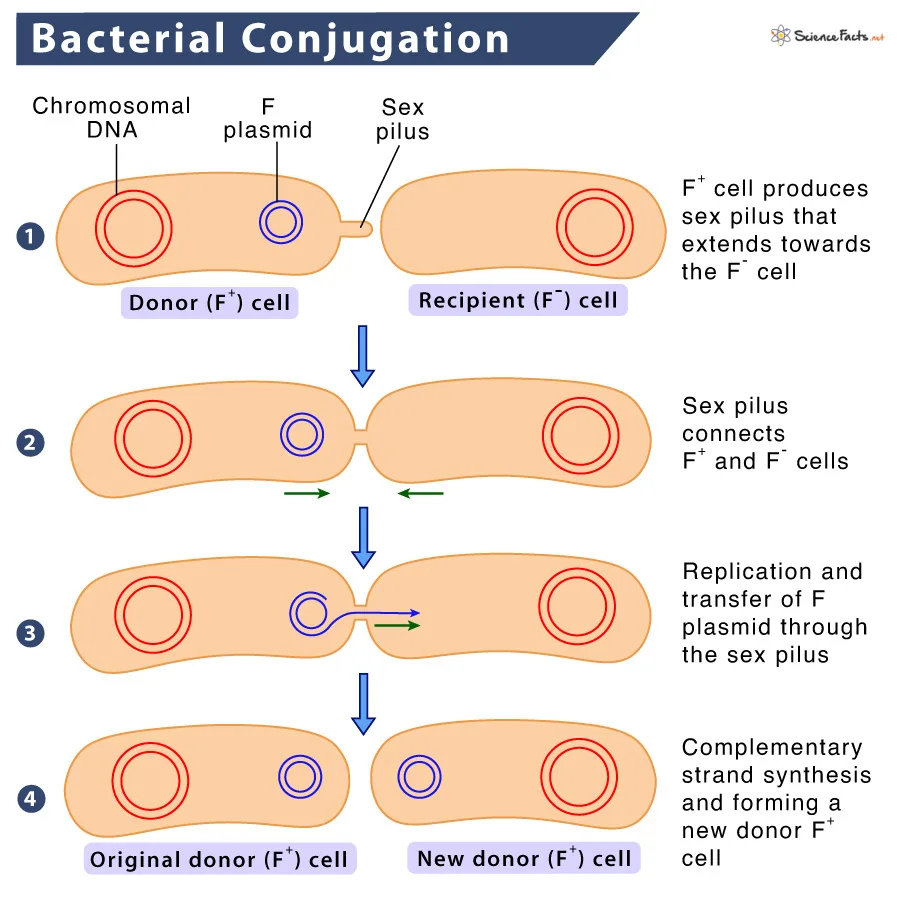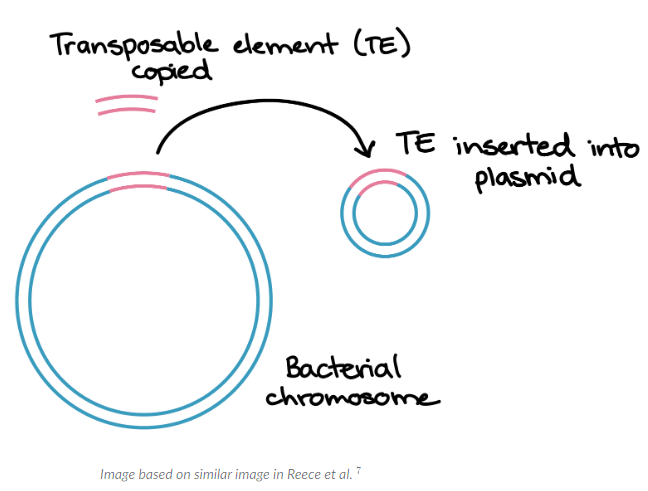- Bacterial conjugation is the process of transfer of genetic materials from one bacterial cell to another bacterial cell by direct cell to cell contact.
- A thin tube like structure is formed between two bacterial cells which are called pilus from where the genetic materials are transferred from one cell to another.
- A small plasmid, known as F plasmid is a genetic material that is transferred during bacterial conjugation.
- In F plasmid, F is referred as fertility factor which replicates in the cytoplasm separately from the bacterial chromosome. Joshua Lederberg and Edward Tatum discovered the conjugation process in 1946.

- During conjugation, the bacterium that donates genetic material is the donor cell that has a copy of F plasmid and is called F-positive, F-plus or F+ cell and the other bacterium receiving is the recipient cell which lacks F plasmid and is called F-negative, F-minus or F– cell.
- The donor bacterium carries the F factor which allows the cell to produce a pilus which helps to draw the two bacterial cells together and forms contacts with recipient.
- It is a horizontal mode of transfer, at this time; the donor bacterium transfers its genetic material to the recipient bacterium through a pilus bridge.
- Different enzymes are also involved in membrane fusion of the two cells after transfer of genetic material. These recipients are called as transconjugants.
- Conjugation process can transfer DNA of hundreds to thousands of kilo base pair which is why it is the broadest range of DNA transfer among the bacterial exchange methods.
- If the F plasmid of a donor cell is integrated in the cell’s chromosome then a part of chromosomal DNA can also get transferred with the F plasmid to the recipient cell.
- Conjugation occurs in and between plants and different species of bacteria including Gram negative and Gram positive bacteria.
- This transfer of genetic material has some genetic advantage to the recipient like antibiotic resistance genes, xenobiotic tolerance or the ability to use new metabolites.
Process of bacterial conjugation
A donor cell and a recipient cell must come in close contact in order to transfer the F plasmid. The F plasmid of the donor cell is double stranded DNA molecule that forms a circular structure before being transferred from one bacterial cell to another. The following steps are involved in the process of bacterial conjugation:

Step 1: Formation of pilus
The F plasmid present in the F+ donor cell contains a tra locus which includes pilin genes that forms sex pilus on the cell surface.
Step 2: Physical contact between donor and recipient cell
The pilus projects out and forms a bridge and begins contact with F– (recipient) cell.
Step 3: Transfer of F plasmid
- The F plasmid is in a circular form as it consists of double stranded DNA molecule which is in attached form in both the ends and opens up at Ori T site.
- An enzyme called relaxase or relaxosome forms a complex with other proteins and cuts at the origin in one of the two DNA strands and the 5’ end strand is transferred to the recipient cell. The cut strand is also called as T strand.
- The enzyme involved in the membrane fusion is traD enzyme which is located at the base of the pilus.
Step 4: Complementary strand synthesis
- A single stranded DNA of F plasmid is present in both the donor cell and recipient cell.
- The replication occurs and ends up forming a double stranded F plasmid identical to the original F plasmid.
- The formed F plasmid contains genetic information and ability to synthesize pili and other proteins which now becomes a new donor cell.
- Now both cells become donor cells or F+ cell.
Transposable elements
Transposable elements are the sequence of DNA that sometimes causes alteration of genetic identity and results in the duplication of the same genetic material. Transposable elements are an important part of gene evolution and regulation.
Transposable elements (TEs) are also present in all bacterial cells and are important as it sometimes carry antibiotic resistance genes and pathogenecity genes. These TEs jump from one place to another within a genome, cutting and pasting themselves. If one of these TEs jumps from the chromosome into a plasmid, its genes can be easily passed by transformation or conjugation process.

Application of bacterial conjugation
- Conjugation is applicable in plant engineering like the conjugation between the tumor inducing (Ti) plasmid of Agrobacterium and the root tumor inducing (Ri) plasmid of A. rhizogenes can be effectively transformed into opine producing factories.
- Some antibiotic resistance genes can be transferred to the pathogens that might cause wide spread outbreak.
- Conjugation can be used for gene transferring in laboratories between bacteria and yeasts, plants and mammalian cells.
References:
- https://www.nature.com/scitable/definition/conjugation-prokaryotes-290/
- https://biologydictionary.net/bacterial-conjugation/
- https://www.khanacademy.org/science/ap-biology/gene-expression-and-regulation/mutations-ap/a/genetic-variation-in-prokaryotes
- https://www.onlinebiologynotes.com/bacterial-conjugation/